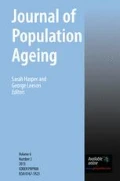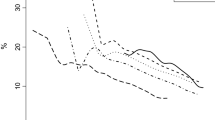Abstract
Policy-makers and practitioners need a good understanding of older people’s expenditure and consumption to inform the design of policies and services that affect their lives. This paper uses data from the 2010 Living Costs and Food Survey to examine and explain levels and patterns of expenditure among households headed by someone aged 50 and over. Expenditure is defined based on 12 broad categories, which reflect the international standard ‘Classification of Individual Consumption according to Purpose’, and is equivalised to control for household size. We report the results of cluster analysis which segments older households depending on their predominant patterns of expenditure. CHAID (decision tree) analysis and bivariate analysis is then used to understand the profile of each cluster in relation to their demographic, socio-economic and other characteristics. Based on their patterns of expenditure, six distinct clusters of older households emerge from the analysis. The findings raise important questions for government policy in the UK in relation to the extent and nature of expenditure poverty among older consumers.
Similar content being viewed by others
Notes
The OECD modified equivalence scale is the standard scale used for equivalising income by the Statistical Office of the European Communities (EUROSTAT) and is used widely across government in the UK. The scale assigns an equivalence scale of 1 to the first adult in a household. Each subsequent adult and child aged 14 and over is assigned a value of 0.5 and each child aged under 14 is assigned a value of 0.3 (Office for National Statistics 2013).
Details of the cluster analysis methodology are available from the authors on request.
Explanation of CHAID analysis from Shury et al. 2004.
The variation in average spending by cluster on each of these categories was highly significant in ANOVAs (p < 0.001).
All reported differences between clusters are statistically significant (p < .05).
References
Banks, J., & Leicester, A. (2006). Expenditure and Consumption. Institute for Fiscal Studies. Available at: http://www.ifs.org.uk/elsa/report06/ch9.pdf [Accessed on 15 August 2013].
Berthoud, R., Blekesaune, M., & Hancock, R. (2006). Are ‘poor’ pensioners ‘deprived’? (DWP Research Report 364). Leeds: Corporate Document Services.
Crawford, R., & Emmerson, C. (2012). NHS and Social Care Funding: The outlook to 2021/22. Report commissioned by Nuffield Trust. Available at: http://www.nuffieldtrust.org.uk/sites/files/nuffield/publication/120704_nhs-social-care-funding-outlook-2021-22_0.pdf [accessed 6 August 2013].
Dilnot Commission. (2011). Commission on Funding of Care and Support. [online] Available at: <http://www.dilnotcommission.dh.gov.uk/> [Accessed 15 July 2013].
Dixon, P. (2008). Marketing to Older Consumers. In: Marketeer. Available at: http://www.globalchange.com/marketing-to-older-consumers.htm [Accessed 15 July 2013].
Eastman, J. K., & Iyer, R. (2005). The impact of cognitive age on internet use of the elderly: an introduction to the public policy implications. International Journal of Consumer Studies, 29(2), 125–136.
Eurostat, no date. Glossary: Classification of Individual consumption by purpose. Available at: http://epp.eurostat.ec.europa.eu/statistics_explained/index.php/Glossary:Classification_of_individual_consumption_by_purpose_(COICOP) [Accessed 12 August 2013].
Gregg, P., Harkness, S., & Machin, S. (1999). Poor kids: trends in child poverty in Britain, 1968–96. Fiscal Studies, 20(2), 163–187.
Hair, J. P., et al. (2006). Multivariate data analysis (6th ed.). New Jersey: Prentice Hall.
Higgs, P. F., et al. (2009). From passive to active consumers? Later life consumption in the UK from 1968–2005. The Sociological Review, 57(1), 102–124.
Hill, K., Sutton, L., & Hirsch, D. (2012). Living on a low income in later life. London: Age UK.
Hirsch, D., Davis, A., & Smith, N. (2009). A minimum income standard for Britain in 2009. Loughborough: Joseph Rowntree Foundation.
Joseph Rowntree Foundation. (2013). The links between housing and poverty. Available at: https://mailattachment.googleusercontent.com/attachment/u/0/?ui=2&ik=ec79ae0be3&view=att&th=14080de1d3c8df1d&attid=0.1&disp=inline&realattid=f_hkdn9e2o0&safe=1&zw&saduie=AG9B_P_OEAKP3CFupiDWsWuMZEbp&sadet=1377771601130&sads=8P2WfT0QfULu44GYiddBtqGJXPY [Accessed 29 August 2013].
Kass, G. V. (1980). An exploratory technique for investigating large quantities of categorical data. Applied Statistics, 29(2), 119–127.
Kingman, D. (2012). Spending power across the generations. Intergenerational foundation. Available at: http://www.if.org.uk/wp-content/uploads/2013/01/Spending-Power-Across-the-Generations-Report.pdf [Accessed 15 August 2013].
Levell, P., & Oldfield, Z. (2011). The spending patterns and inflation experience of low-income households over the past decade. London: Institute for Fiscal Studies.
Leventhal, R. (1997). Aging Consumers and their effects on the marketplace (The aging consumer). Journal of Consumer Marketing, 14, 276–280.
Littrell, M. A., Ma, Y. J., & Halepete, J. (2005). Generation X, baby boomers, and swing: marketing fair trade apparel. Journal of Fashion Marketing and Management, 9(4), 407–419.
Meyer, B. D., & Sullivan, J. X. (2012). Identifying the disadvantaged: official poverty, consumption poverty, and the new supplemental poverty measure. Journal of Economic Perspectives, 26(3), 111–136.
Moschis, G. P. (1996). Life stages of the mature market. American Demographics, 18(9), 44–51.
OECD, no date, What are equivalence scales? Available at: http://www.oecd.org/eco/growth/OECD-Note-EquivalenceScales.pdf [Accessed on 6 August 2013].
Office for National Statistics. (2008). Family Spending. A report on the 2007 expenditure and food survey. Basingstoke: Palgrave Macmillan.
Office for National Statistics. (2011a). Living Costs and Food Survey User Guide Volume A – Introduction: January – December 2010 - Great Britain & Northern Ireland, 2011. ONS Social Surveys.
Office for National Statistics. (2011b). Family Spending. A report on the 2010 expenditure and food Survey. Basingstoke: Palgrave Macmillan.
Office for National Statistics. (2013). Households Below Average Income: An analysis of the income distribution 1994/95 – 2011/12. A report for the Department for Work and Pensions. Available at: https://www.gov.uk/government/uploads/system/uploads/attachment_data/file/206778/full_hbai13.pdf [Accessed on 7 August 2013].
Peto, R., Lopez, A. D., Boreham, J., Thun, M., Heath, C., Jr., & Doll, R. (1996). Mortality from smoking worldwide. British Medical Bulletin, 52, 12–21.
Reisenwitz, T., Iyer, R., Kuhlmeier, D. B., & Eastman, J. K. (2007). The elderly’s internet usage: an updated look. Journal of Consumer Marketing, 24(7), 406–418.
Saunders, P., Bradshaw, J., & Hirst, M. (2002). Using household expenditure to develop an income poverty line. Social Policy and Administration, 39, 217–234.
Shury, J., Speed, M., Vivian, D., Kuechel, A. & Nicholas, S. (2004). Crimes against retail and manufacturing premises: findings from the 2002 Commercial Victimisation Survey. Supplementary Web Report 3 to OLR 37/05: CHAID Analysis. London: Home Office. Available at http://webarchive.nationalarchives.gov.uk/20100413151441/http://www.homeoffice.gov.uk/rds/pdfs05/rdsolr3705supp3.pdf.
Simcock, P., & Sudbury, L. (2006). The invisible majority? Older models in UK television advertising. International Journal of Advertising, 25(1), 87–106.
Singleton, A., no date. Output Area Classification in Hampshire. Available at: http://www3.hants.gov.uk/output_area_classification_guide_and_hampshire_profile.pdf [Accessed on: 7 August 2013].
Skoufias, E., Lindert, K., Fazio, M. V., Lanjouw, P. F., Leite, P. (2007). Brazil: Measuring poverty using household consumption, World Bank.
Sudbury, L., & Simcock, P. (2009). A multivariate segmentation model of senior consumers. Journal of Consumer Marketing, 26(4), 251–262.
Sudbury, L., & Simcock, P. (2011). Bargain hunting belongers and positive pioneers: key silver market segments in the UK. In F. Kholbach & C. Herstatt (Eds.), The silver market phenomenon: business opportunities in an era of demographic change (2nd ed.). Dordrecht: Springer.
Acknowledgments
We are grateful to the Economic and Social Research Council for funding this work as part of their Secondary Data Analysis Initiative. For further information on our programme of work, please see our website: http://www.bris.ac.uk/geography/research/pfrc/esrc/. Thanks also to Professor Kelvyn Jones and Dr David Manley for advice, and to the two anonymous referees for their helpful comments on an earlier draft of this paper.
Author information
Authors and Affiliations
Corresponding author
Rights and permissions
About this article
Cite this article
Hayes, D., Finney, A. Dominant Patterns of Expenditure Among Older People in the United Kingdom: Segmenting the Older Consumer Using the Living Costs and Food Survey. Population Ageing 7, 97–113 (2014). https://doi.org/10.1007/s12062-014-9097-4
Received:
Accepted:
Published:
Issue Date:
DOI: https://doi.org/10.1007/s12062-014-9097-4




